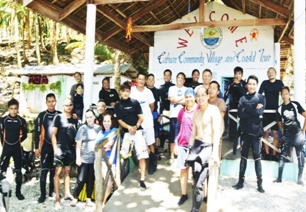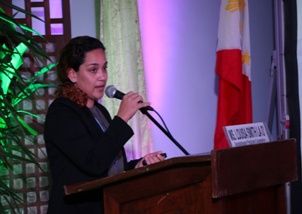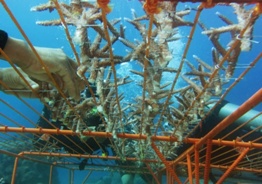 While Camiguin island is essentially known for its sweet lanzones, this province has something more to boast about. The island is blessed with natural attractions such as cool refreshing waters and waterfalls, panoramic view of the ocean, and potential divesites. One of such divesites is in barangay Cabuan, Guinsiliban in Camiguin.
While Camiguin island is essentially known for its sweet lanzones, this province has something more to boast about. The island is blessed with natural attractions such as cool refreshing waters and waterfalls, panoramic view of the ocean, and potential divesites. One of such divesites is in barangay Cabuan, Guinsiliban in Camiguin.
Aware of such potential, the Cabuan Community Village Coastal Tour Association (CCVCTA) collaborated with the Department of Science and Technology and the Philippine Council for Agriculture, Aquatic and Natural Resources Research and Development (DOST-PCAARRD), Sangkalikasan Producers Cooperative (SPC), and the provincial government of Camiguin in addressing coral degradation in the island through the government’s roll-out of Coral Reef Restoration (asexual) Program.
The CCVCTA, an organization registered with the Department of Labor and Employment (DOLE), is composed of 61 members. Its main objective is to monitor and strengthen the protection and conservation of coastal and marine resources in the barangay. The association embodies the people of Cabuan’s strong connection with the sea, spirit of volunteerism, desire to adopt progress that is environmentally sound, and reclaim their identity as a people of the sea, hence its desire to adopt the Coral Reef Restoration (asexual) Program.
Having started in 2014, the Coral Reef Restoration Program rolled out coral transplantation technology using asexually reproduced corals to improve productivity of coral resources for sustainable fisheries. Camiguin, Bohol, Pangasinan, Sarangani, Bataan, Zambales, Palawan, Zamboanga del Norte, and Ilocos Norte were chosen as restoration sites. The sites were selected based on their suitability for restoration; availability of sufficient amount of coral fragments for transplanting; and their location within the marine protec ted area.
ted area.
Dislodged live coral fragments or “corals of opportunity” (COPs) are gathered and attached to coral nursery units (CNUs) so that they can quickly recover and regenerate. Each CNU can hold 500 COPs per batch and can be used several times a year. Ingenious as it is, the technology uses marine epoxy clay, nails, and cable ties.
Louisa Smith La o’, member of the SPC, presented the organization’s accomplishment as a program collaborator during the Sixth General Assembly and Convention of the Philippine-Korea Rural Development Administration Alumni Association (PhilKoRAA) on September 29-30 at the DOST-PCAARRD Innovation and Technology Center (DPITC), in Los Baños, Laguna.
Adopting the theme, Tec hnology Transmission to Community Transformation, the event highlighted the outcomes or impacts of technology transfer initiatives in transforming communities.
hnology Transmission to Community Transformation, the event highlighted the outcomes or impacts of technology transfer initiatives in transforming communities.
La o’ shared that with the DOST-PCAARRD program on coral restoration, ten coral nursery units (CNUs) are designed through the DOST-funded Filipinnovation program and two SPC-designed CNUs have been deployed underwater with 5,000 and 3,000 COPs, respectively. This has helped in improving not only the coral reefs but also the marine ecosystem as evidenced by the increase in fish density and marine biodiversity.
Aside from what have been restored, the program has also institutionalized certain mechanism towards a sustainable underwater tourism. For one it has initiated the Eco Dive Tourism Education and Briefing, DOST-PCAARRD’s coral propagation main tool. It has also provided divers with the opportunity to experience coral restoration as an added feature of the dive.
With the success of the technology in Cabuan, Louisa said, “Today, we are no longer just divers. We have the power to bring back life to the sea.”
